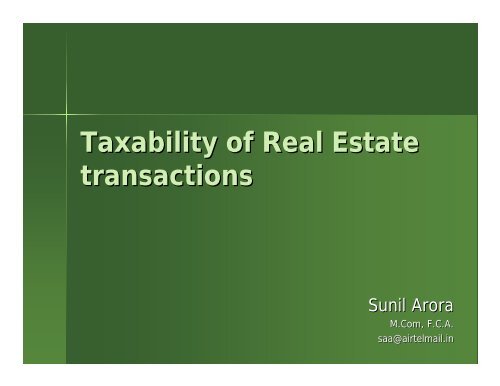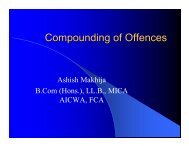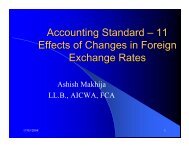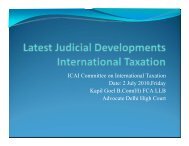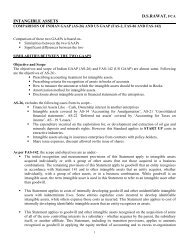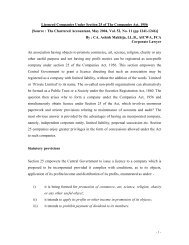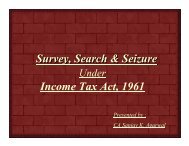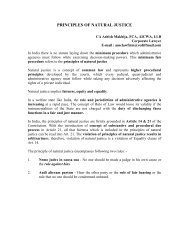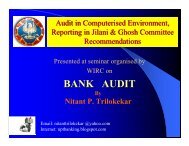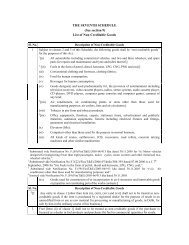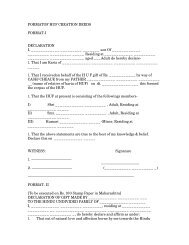Taxability of Real Estate transactions
Taxability of Real Estate transactions
Taxability of Real Estate transactions
You also want an ePaper? Increase the reach of your titles
YUMPU automatically turns print PDFs into web optimized ePapers that Google loves.
<strong>Taxability</strong> <strong>of</strong> <strong>Real</strong> <strong>Estate</strong><br />
<strong>transactions</strong><br />
Sunil Arora<br />
M.Com, , F.C.A.<br />
saa@airtelmail.in
Understatement <strong>of</strong><br />
consideration<br />
• What is the recourse available with the<br />
AO <br />
• Can AO refer to the Valuation Officer<br />
for ascertaining FMV <strong>of</strong> the transferred<br />
capital asset <br />
• What are the consequences if the<br />
Valuation Officer arrives at a value<br />
higher than the stated consideration
Reference to Valuation<br />
Officer<br />
• Section 55A <strong>of</strong> the Income tax Act,<br />
1961<br />
• Specific powers to the AO for referring<br />
to the Valuation Officer if in the<br />
opinion <strong>of</strong> AO the value <strong>of</strong> the asset as<br />
claimed by the assessee is less than<br />
the FMV <strong>of</strong> the asset.<br />
• Reference only for the purpose <strong>of</strong><br />
ascertaining FMV for the purpose <strong>of</strong><br />
Chapter IV <strong>of</strong> the Act
Reference to Valuation<br />
Officer<br />
• Reference in the case <strong>of</strong> property<br />
purchased or constructed, etc<br />
• Addition by the AO u/s 69, 69B, 69A <strong>of</strong><br />
the Act which fall in Chapter VI which<br />
is outside the purview <strong>of</strong> section 55A<br />
• Amiya Bala Paul 262 ITR 407 (SC)<br />
• Section 142A introduced by The<br />
Finance (No. 2) Act, 2004 w.r.e.f. . 15-<br />
11-1972<br />
1972
Section 142A<br />
• To estimate the value <strong>of</strong> any<br />
investment referred to in section 69,<br />
69B, 69A <strong>of</strong> the Act<br />
• Introduced by The Finance (No. 2)<br />
Act, 2004 but made effective from 15-<br />
11-1972<br />
1972<br />
• Proviso to the effect that section not<br />
to apply to assessments which have<br />
become final & conclusive before 30 th<br />
day <strong>of</strong> September, 2004<br />
ACIT v. Shakti Bldrs (2005) 93 ITD269(ITAT-DEL)<br />
DEL)
Valuation for Stamp Duty<br />
• Actual consideration < Value for<br />
Stamp Duty<br />
• Actual consideration that passed<br />
between the parties is a question <strong>of</strong><br />
fact to be determined in each case<br />
having regard to the facts &<br />
circumstances <strong>of</strong> the case.<br />
Dinesh Kr Mittal v. ITO (1992) 193 ITR 770 (All)<br />
• Section 50C introduced by The Finance<br />
Act, 2002 w.e.f. . 1-4-20031
Section 50C<br />
• Value for the purpose <strong>of</strong> stamp duty,<br />
deemed to be the full value <strong>of</strong> the<br />
consideration from transfer <strong>of</strong> the<br />
capital asset for calculating capital<br />
gains<br />
• In case the value is disputed before<br />
the AO and the stamp duty valuation<br />
has not been disputed; the AO may<br />
refer to a Valuation Officer for<br />
ascertaining FMV
Issues in section 50C<br />
• Consequences in case value arrived at by the<br />
Valuation Officer is:<br />
– less the than stamp duty valuation<br />
– more than the stamp duty valuation<br />
• In case the stamp duty valuation is disputed before<br />
the concerned authority; Section 155(15)<br />
• Section 50C applicable only to the seller but 142A<br />
may be invoked to make addition in the hands <strong>of</strong><br />
the buyers.<br />
• How the seller can avail benefit u/s 54/ 54EC
Questions<br />
• Whether AO can refer a capital asset<br />
to the Valuation Officer for<br />
ascertaining the FMV <strong>of</strong> the asset <br />
• What are the consequences in case<br />
the Valuation Officer arrives at a FMV<br />
higher than the stated consideration
Reference to DVO<br />
• 55A<br />
: For assessment <strong>of</strong> capital gains<br />
• 142A : For ascertaining cost <strong>of</strong><br />
acquisition <strong>of</strong> property<br />
• 50C<br />
: In case stamp duty valuation is<br />
more than the stated consideration &<br />
the assessee does not accept the<br />
same for assessment <strong>of</strong> capital gains.
Consequences <strong>of</strong> higher<br />
valuation by DVO<br />
Section 142A(3)<br />
On receipt <strong>of</strong> the report from the<br />
Valuation Officer, the Assessing Officer<br />
may, after giving the assessee an<br />
opportunity <strong>of</strong> being heard, take into<br />
account such report in making such<br />
assessment or reassessment
Consequences <strong>of</strong> higher<br />
valuation by DVO<br />
Section 50C<br />
• Consequences in case value arrived at by<br />
the Valuation Officer is:<br />
– less the than stamp duty valuation<br />
– more than the stamp duty valuation<br />
• In case the stamp duty valuation is disputed<br />
before the concerned authority; Section<br />
155(15)
Understatement <strong>of</strong><br />
consideration<br />
• Whether valuation report is an<br />
evidence sufficient for making<br />
addition<br />
• Whether addition on the basis <strong>of</strong><br />
valuation report can be made in the<br />
hands <strong>of</strong> buyer or seller
Understatement <strong>of</strong><br />
consideration<br />
• Section 52(2):<br />
FMV <strong>of</strong> the asset transferred exceeds the stated<br />
consideration by 15% than FMV be taken as the full<br />
value <strong>of</strong> consideration for the transfer.<br />
• K.P. Verghese V. ITO.(1981) 131 ITR 597 (SC)<br />
Onus on the revenue to show that the FMV <strong>of</strong> the<br />
asset exceeds the stated consideration but also<br />
that the consideration had been understated and<br />
the assessee had actually received more than what<br />
was declared by him.<br />
• Section 52 deleted from the statute by The Finance<br />
Act,1987
Consequences<br />
• K.P. Verghese v. ITO (1981) 131 ITR 597 (SC)<br />
• CIT v. George Handerson & Co. Ltd (1967) 66<br />
ITR 622 (SC)<br />
• CIT v. Gillander Arbuthnot & Co ( 1973) 87 ITR<br />
407 (SC)<br />
• CIT v. Rakesh Kumar, SLP (civil) No. 3330 /<br />
1982 (1988) 171 ITR (ST) 47 (SC)
Understatement <strong>of</strong><br />
consideration<br />
• Expert valuer confirming the valuation as<br />
per the sale deed<br />
• Valuation <strong>of</strong>ficer <strong>of</strong> the department arrived<br />
at a higher value<br />
• Lordships Sabyasachi Mukherji and<br />
S.Ranganathan JJ. Dismissed departments<br />
special leave petition against the orders <strong>of</strong><br />
the Delhi High Court holding that no<br />
understatement <strong>of</strong> value was proved<br />
CIT v. Rakesh Kumar 171 ITR (ST) 47 (SC)<br />
ACIT v. Shakti Bldrs (2005) 93 ITD269(ITAT-DEL)<br />
DEL)
Understatement <strong>of</strong><br />
consideration<br />
• AO can substitute actual sale<br />
consideration in place <strong>of</strong> stated<br />
consideration, if there is evidence to<br />
show that the assessee had indeed<br />
received higher amount<br />
Inderpal Singh Ahuja v. CIT (2006) 103 ITD 271<br />
(ITAT-Asr<br />
Asr)
FMV ascertained by DVO<br />
• No addition can be made only on the basis<br />
<strong>of</strong> FMV <strong>of</strong> the asset acquired but<br />
• Addition can be made u/s 69B in case<br />
inference can be drawn on the basis <strong>of</strong><br />
material on record that the assessee has<br />
invested more amount<br />
• Addition to the stated consideration made<br />
u/s 69B held to be valid & the finding <strong>of</strong><br />
ITAT regarding value <strong>of</strong> the property upheld<br />
being a finding <strong>of</strong> fact<br />
Smt Amar Kumari Surana v. CIT (1996) 89 Taxman 544<br />
(Raj)
Understatement <strong>of</strong><br />
consideration<br />
• Agreement as well as other documents<br />
seized during the course <strong>of</strong> search stating<br />
amounts more than the sale consideration<br />
as per the sale deed<br />
• Held; The court cannot come to the<br />
conclusion that the price mentioned in the<br />
sale deed is not correct unless it is proved<br />
that the amount stated in the agreement<br />
was paid<br />
CIT v. K.C. Agnes and others<br />
(2003) 262 ITR 354 (Ker(<br />
Ker)
Issues in section 50C<br />
• Finality as regards consequences <strong>of</strong><br />
variation as per section 50C not binding.<br />
Ravi Kant v. ITO (ITA No. 3671 <strong>of</strong> 2006) dt<br />
13/7/07 (Delhi)<br />
• Provision yet to be tested in the light <strong>of</strong><br />
decision in the case <strong>of</strong> K.P. Verghese V.<br />
ITO.(1981) 131 ITR 597 (SC)
Conclusion<br />
• AO can refer such cases to Valuation Officer<br />
• FMV determined by the DVO may result in<br />
addition: u/s 69B in the hands <strong>of</strong> the buyer<br />
: u/s 50C in the hands <strong>of</strong> the seller<br />
• Decision <strong>of</strong> ITAT in this regard may be very<br />
crucial because the value <strong>of</strong> the asset is a<br />
finding <strong>of</strong> fact<br />
• Case <strong>of</strong> the assessee needs to be properly<br />
built and argued
Pr<strong>of</strong>it on sale <strong>of</strong> property<br />
used for Residence<br />
Section 54<br />
Basic Conditions<br />
- Individual or HUF<br />
- Transfer <strong>of</strong> long term capital asset<br />
- buildings or lands appurtenant thereto<br />
- Residential house<br />
- The income <strong>of</strong> which is chargeable under the head “income<br />
from house property”<br />
Compliance for exemption<br />
- Purchase a residential house<br />
- one year before<br />
- two year after<br />
the date <strong>of</strong> transfer<br />
- constructed a residential house<br />
- with in period <strong>of</strong> 3 year<br />
after the date <strong>of</strong> transfer<br />
- Restriction on transfer <strong>of</strong> new asset
Exemption U/s 54<br />
Capital Gains > Cost <strong>of</strong> the new<br />
residential house<br />
- diff liable to tax u/s 45.<br />
Capital Gains < Cost <strong>of</strong> the new<br />
residential house<br />
- No taxability u/s 45.
New Asset<br />
- Not to be transferred with in a period <strong>of</strong> 3 years<br />
<strong>of</strong> its purchase or construction as the case may<br />
be<br />
- In case transferred:<br />
Gain to be short term capital gain<br />
Cost <strong>of</strong> acquisition depends upon extent <strong>of</strong><br />
exemption availed at the time <strong>of</strong> its acquisition<br />
- if fully exhausted - Nil<br />
- Otherwise<br />
- Balance
Pr<strong>of</strong>it on sale <strong>of</strong> capital asset other than<br />
residential house<br />
Section 54F<br />
Basic Conditions<br />
- Individual or HUF<br />
- Transfer <strong>of</strong> long term capital asset<br />
- Other than residential house<br />
Compliance for exemption<br />
- Purchase a residential house<br />
- one year before or<br />
- two year after<br />
the date <strong>of</strong> transfer or<br />
- constructed a residential house<br />
- with in period <strong>of</strong> 3 year<br />
after the date <strong>of</strong> transfer<br />
- Eligibility as well as other conditions to be fulfilled
Conditions for section 54F<br />
• Assessee should not own more than one<br />
residential house other than the new asset<br />
on the date <strong>of</strong> transfer <strong>of</strong> the original asset<br />
• Should not purchase/ construct any other<br />
residential house within two years / three<br />
years respectively <strong>of</strong> the transfer <strong>of</strong> the<br />
original asset<br />
• New asset not to be transferred before<br />
three years from the date <strong>of</strong> its purchase/<br />
construction, in case transferred LTCG<br />
exempted earlier to be taxed in the year <strong>of</strong><br />
sale
Exemption U/s 54F<br />
Net consideration > Cost <strong>of</strong> the new<br />
residential house<br />
- diff liable to tax u/s 45.<br />
Net consideration < Cost <strong>of</strong> the new<br />
residential house<br />
- No taxability u/s 45.
Diff between 54 & 54F<br />
• Transfer <strong>of</strong> residential house ; any other capital<br />
asset<br />
• Restriction on ownership <strong>of</strong> one residential house at<br />
the time <strong>of</strong> transfer u/s 54F<br />
• Net sale consideration to be invested for exemption<br />
u/s 54F<br />
• Restriction on purchase within 2yrs / construction<br />
within 3yrs <strong>of</strong> any other residential house u/s 54F<br />
• In case sale <strong>of</strong> new asset within 3 yrs:<br />
– Section 54: Cost <strong>of</strong> acquisition <strong>of</strong> the asset to be adjusted<br />
with the amount <strong>of</strong> exemption availed<br />
– Section 54F: LTCG taxable in the year <strong>of</strong> sale <strong>of</strong> the new<br />
asset
Cost <strong>of</strong> plot<br />
• Whether cost <strong>of</strong> plot for the purpose<br />
<strong>of</strong> construction <strong>of</strong> residential house is<br />
considered for benefit u/s 54/ 54F <br />
• Cost <strong>of</strong> land is the integral part <strong>of</strong> the<br />
cost <strong>of</strong> residential house<br />
• Circular No. 667 dt 18/10/1993
Issues in section 54/ 54F<br />
• Benefit restricted for either purchase<br />
or construction <strong>of</strong> a residential house<br />
or both can be considered jointly <br />
• Benefit available for both jointly<br />
• BB Sarkar v. CIT 132 ITR 150 (cal)
Purchase <strong>of</strong> more than<br />
one house<br />
• Whether benefit u/s 54 is available for<br />
purchase <strong>of</strong> more than one house <br />
• Section 54/54F : “a a residential<br />
house”<br />
• Whether “a” here denotes “one”
Purchase <strong>of</strong> more than<br />
one house<br />
• Benefit restricted to only one house<br />
KC Kaushik v. ITO (1990) 185 ITR 499<br />
(Bom)<br />
• KG vyas v. ITO 16 ITD 195 ( ITAT- Mum)<br />
• The controversy and the judicial<br />
precedents above was on section as it<br />
stood before amendment by The<br />
Finance Act, 1982 where benefit was<br />
restricted to “a a house property for the<br />
purpose <strong>of</strong> his own residence”
Purchase <strong>of</strong> more than<br />
one house<br />
• The General Clauses Act, 1897:<br />
Section 13(2): “words in the singular shall include<br />
the plural, and vice versa”<br />
• The article “a” is not necessarily a singular term. It<br />
is <strong>of</strong>ten used in the sense <strong>of</strong> any, and when so used<br />
it may be applied to more than one individual<br />
object- National Union Bank v. Copeland 4NE 794<br />
• Two adjacent flats; Held allowable; D. Anand<br />
Basappa v. ITO (2004) 91 ITD 53 (Bang.)<br />
• Held allowed only for one flat; Gulshanbanoo R.<br />
Mukhi v. JCIT (2002) 83 ITD 649 (ITAT- Mum)<br />
• Held: Not allowable except in the case <strong>of</strong> adjacent<br />
& contiguous flats; ITO v. Mrs Sushila M. Jhaveri<br />
107 ITD 327 (ITAT- Mum. SB)
Land & building<br />
• Land purchased in 1991<br />
• Residential house constructed thereon in<br />
1995<br />
• Sold in 1996<br />
• Whether gain is short term or long term<br />
CIT v. lakshmi b Menon (2003) 184 CTR 52 (Ker(<br />
Ker)<br />
Capital gains to be determined seperately
Execution <strong>of</strong> sale deed<br />
• Payment made but sale deed could<br />
not be executed with in 2yrs; whether<br />
assessee is entitled to benefit u/s 54 <br />
• Legal transfer not mandatory,<br />
payment <strong>of</strong> consideration coupled with<br />
taking over <strong>of</strong> possession is more<br />
important<br />
CIT v. Dr Laxmichand (1995) 211 ITR 804 (Bom(<br />
Bom)<br />
CIT v. Shahzada Begum (1988) 175 ITR 397(AP)
New house in wife’s s name<br />
• Capital gains from sale <strong>of</strong> residential<br />
house property in the name <strong>of</strong><br />
husband<br />
• New residential house purchased in<br />
the name <strong>of</strong> wife<br />
• Exemption u/s 54 allowable<br />
CIT v. Natrajan (2006) 287 ITR 271<br />
(Mad)
Section 54F<br />
• Pre condition that assessee should not own<br />
more than 1 residential house<br />
• Share in a joint property is ‘owned wholly or<br />
partly’ whereas in section 54F the word is<br />
‘owned’<br />
• For denial <strong>of</strong> exemption u/s 54F the<br />
assessee should own a complete residential<br />
house and does not include shared interest<br />
in a residential house<br />
ITO vs Rasik Lal N Satra (2006) 98 ITD 335 (Mum)
Acquisition <strong>of</strong> share in<br />
property<br />
• Assessee purchases 15% share in the<br />
residential house property in which he<br />
was already staying<br />
• Exemption u/s 54 cannot be denied<br />
CIT vs Chandan ben Magan Lal (2000) 245 ITR 182<br />
(Guj)<br />
CIT vs TN Arvinda Reddy (1979) 120 ITR 46 (SC)
Non residential use <strong>of</strong><br />
house<br />
• House purchased / sold u/s 54 / 54F<br />
although being a residential house is being<br />
utilized for non-residential purposes<br />
• Mere non-residential use <strong>of</strong> residential<br />
house would not render property ineligible<br />
for benefit u/s 54/ 54F<br />
Mahavir Prasad Gupta (2006) 5 SOT 353 (Del)<br />
Amit Gupta v. DCIT (2006) 6 SOT 403 (Delhi)
Purchase <strong>of</strong> residential<br />
house outside India<br />
• Whether assessee entitled to exemption u/s<br />
54/ 54F<br />
• Held: No, Income Tax Act, 1961 applies only<br />
to India<br />
Leena J Shah v. ACIT (2006) 6 SOT 721 (Ahd(<br />
Ahd)<br />
• Held: Yes, section 54 does not impose any<br />
bar on acquisition outside India<br />
Prema P Shah v. ITO 282 ITR (ITAT) (Mum.)
Collaboration agreement<br />
• Whether repurchase <strong>of</strong> a part <strong>of</strong> the<br />
property sold will entitle assessee to<br />
claim benefit u/s 54<br />
• Held, yes<br />
CIT v. Phiroze H. Patel (1994) 205 ITR 377 (Bom(<br />
Bom)
Construction whether<br />
before or after the date <strong>of</strong><br />
transfer<br />
• Whether construction <strong>of</strong> house property can<br />
be completed before the date <strong>of</strong> transfer <strong>of</strong><br />
the original asset<br />
• Held, No<br />
Smt Shantaben P.Gandhi (1981) 129 ITR 218 (Guj(<br />
Guj)<br />
CIT v. JR Subramanya Bhat (1987) 165 ITR 571<br />
• Whether it can be started before the date <strong>of</strong><br />
transfer<br />
• Held, Yes<br />
CIT v. HK Kapoor (1998) 150 CTR 128 (All)
Payment for SFS/ CGHS<br />
flat<br />
• Whether to be taken as construction<br />
or purchase <strong>of</strong> residential house<br />
• To qualify for construction<br />
• Circular No. 471 dt 19-10<br />
10-19861986<br />
• Circular No. 672 dt 16-12<br />
12-19931993
Purchase/ construction<br />
• Property being developed by the<br />
builder under collaboration agreement<br />
• Assessee to get some portion <strong>of</strong> the<br />
dwelling unit<br />
• Whether time limit <strong>of</strong> 2 yrs or 3 yrs<br />
would apply <br />
• The case would fall under purchase <strong>of</strong><br />
property by way <strong>of</strong> construction<br />
ITO v. Abbas Ali Shiraz (2006) 5 SOT 422 (Bang.)<br />
• Construction may be by a third party<br />
CIT v. Uma Budhia (2004) 141 Taxman 39 (Kol(<br />
Kol.)
Construction with in 3<br />
years<br />
• Assessee has made payments out <strong>of</strong> the<br />
capital gains with in the stipulated time<br />
• Builder failed to hand over the property with<br />
in the prescribed time<br />
• Exemption u/s 54/ 54F cannot be denied<br />
CIT vs RC Sood (2000) 108 Taxman 227 (Del)<br />
CIT vs Ms Hille JB Wadia (1995) 216 ITR
Incomplete house<br />
• Capital gains invested in construction<br />
<strong>of</strong> residential house with in the<br />
stipulated time<br />
• More funds required to complete the<br />
construction in a particular manner<br />
• Assessee entitled to exemption as the<br />
utilization <strong>of</strong> the capital gains is<br />
complete<br />
• Ajay Goyal v. ITO (ITA No 493 <strong>of</strong> 2004<br />
dt 9-5-2005)
Transformation <strong>of</strong> an<br />
asset<br />
• Assessee books a flat with DDA/ becomes<br />
member <strong>of</strong> a CGHS in 2001<br />
• Possession <strong>of</strong> the flat is given to the<br />
assessee in 2003<br />
• Flat sold in 2005<br />
• Capital gain; whether long term or short<br />
term<br />
Flat is only an incidental right flowing from the<br />
shareholding in the CGHS<br />
vs Jindas Parchand Gandhi (2005) 279 ITR 552<br />
(Guj)<br />
CIT vs
Link capital gain &<br />
investment<br />
• Capital asset sold resulting in long term<br />
capital gains and sale proceeds utilized for<br />
business.<br />
• New residential house property purchased<br />
after getting the same financed from bank<br />
• Other stipulations for exemption complied<br />
• Whether assessee entitled to deduction u/s<br />
54<br />
• Ajit Vaswani v. (2001) CIT 117 Taxman 123<br />
(Delhi) (Mag(<br />
Mag.)
Death <strong>of</strong> the assessee<br />
• Legal heirs entitled to exemption if<br />
conditions satisfied<br />
CV Ramanathan (1980) 155 ITR 191 (Madras)<br />
Mir Ghulam Ali Khan (1987)165 ITR 228 (AP)<br />
• Deposit in Capital Gains Scheme A/C<br />
inherited by the legal heirs<br />
• No obligation to utilize the same for<br />
purchase or construction <strong>of</strong> the residential<br />
house because the same is not income but<br />
estate devolving upon the legal heirs.<br />
Circular No. 743, dt 13-7-1989<br />
1989
Benefit u/s 54/ 54F<br />
• Benefit only for new construction or for<br />
remodeling & renovation also covered<br />
• Benefit not restricted to new construction<br />
alone<br />
CIT v. ar Mathavan pillai (1996) 219 ITR 696 (Ker(<br />
Ker)<br />
CIT v. Narsimhan PV (1990) 181 ITR 101(Mad)<br />
• Mere extension <strong>of</strong> old existing house would<br />
not mean construction. The construction<br />
must be real one and not a symbolic<br />
construction.<br />
CIT v. Pradeep Kumar (2006) 153 Taxman 138<br />
(Madras)
Farm House<br />
• Whether a farm house can be considered as a<br />
residential house for the purposes <strong>of</strong> section 54/<br />
54F<br />
• Land appurtenant to a building is a question <strong>of</strong> fact<br />
• Land appurtenant thereto implies lands which are<br />
necessary for the effective enjoyment <strong>of</strong> the<br />
building as a residential house<br />
• Tests as per judicial precedents<br />
S Radha Krishnan vs CIT (1984) 145 ITR 170 Madras)<br />
CIT vs M Kalpagam (1997) 227 ITR 733 (Madras)<br />
CIT vs Zaibunisa Begum (1985) 151 ITR 320 (AP)<br />
L & T vs Trustees (1988) 4 SCC 260
Indexation<br />
• Father purchased house property for Rs1.16 lac in<br />
the year 1983.<br />
• Father died in the year 2004 and son Mr. X inherits<br />
the property.<br />
• Mr. X sells the property in Nov,05 for Rs5.00 lacs.<br />
• Cost Inflation Index:<br />
– 1983-84: 84: 116<br />
– 2004-05: 05: 480<br />
– 2005-06: 06: 497<br />
• <strong>Taxability</strong> under the head capital gains:<br />
– Short term/ long term<br />
– Cost <strong>of</strong> acquisition<br />
– indexation
Capital asset acquired u/s 49<br />
• Explanation (iii) to Section 48:<br />
Indexed cost <strong>of</strong> acquisition means an amount<br />
which bears to the cost <strong>of</strong> acquisition the same<br />
proportion as Cost Inflation Index for the year in<br />
which the asset is transferred bears to the Cost<br />
Inflation Index for the first year in which the asset<br />
was held by the assessee or for the year begining<br />
on the 1-4-811<br />
which ever is later.<br />
• Date from which indexation to be done <br />
• From the date <strong>of</strong> acquisition <strong>of</strong> the previous owner;<br />
Pushpa S<strong>of</strong>at 81 ITD 1 (ITAT-Chd<br />
Chd)<br />
• From the date <strong>of</strong> inheritence; Kishore Kanungo 102<br />
ITD 437 (ITAT-Mum)
Capital Gains Tax Scheme<br />
Section 54(2)<br />
- unutilized amount <strong>of</strong> capital gains<br />
- Deposit in an account<br />
- With any specified bank or institution<br />
- Scheme notified in <strong>of</strong>ficial gazette by Central<br />
Government<br />
- Before the date <strong>of</strong> furnishing ITR u/s 139(1)<br />
- Pro<strong>of</strong> <strong>of</strong> such deposit to be furnished alongwith the<br />
ITR.<br />
- Withdrawal for purchase/construction <strong>of</strong> new house.<br />
- Unutilized amount chargeable to tax as the income <strong>of</strong><br />
the previous year in which the period <strong>of</strong> three years<br />
expires.
Capital Gains Scheme<br />
• Funds given as advance instead <strong>of</strong><br />
depositing in the Capital Gains Scheme<br />
• Later received back<br />
• Property purchased during the stipulated<br />
time<br />
• Whether benefit u/s 54 or 54F will be<br />
available to the assessee<br />
• “Deminimus<br />
non curat lex”<br />
Rupali R Desai v. ACIT (2005) 273 ITR 109 (ITAT-<br />
MUM)<br />
• Exemption u/s 54F not available<br />
Taranbir Singh Sahni v DCIT(2006)5 SOT 417<br />
(Delhi)
Section 54EC<br />
• Long term capital gains not to be charged<br />
on investment in certain bonds at any time<br />
within a period <strong>of</strong> 6 months from the date <strong>of</strong><br />
transfer<br />
• Specified asset wef 1/4/2006:<br />
– National Highway Authority <strong>of</strong> India<br />
– Rural Electrification Corporation Limited<br />
• Advance invested in specified bonds, while<br />
transfer takes place subsequently<br />
– Whether assessee entitled to benefit u/s 54EC<br />
– Circular No. 359 dt 10-5-1983<br />
1983<br />
• Bonds transferred / security for loan with in<br />
3 yrs
Section 54GA<br />
• Shifting from urban area to any SEZ<br />
• Capital gains arising from transfer <strong>of</strong> land &<br />
building, plant & machinery exempt from<br />
tax in case utilised for establishment <strong>of</strong><br />
undertaking in SEZ<br />
• The capital gains to be utilised within 1 yr<br />
before or 3 yrs after the date <strong>of</strong> transfer for:<br />
– Purchase <strong>of</strong> plant & machinery<br />
– Land & building<br />
– Other expenses as may be specified by the CG<br />
• SEZ may be in an urban area or any other<br />
area
SEZ<br />
• Section 54GA inserted by the Special<br />
Economic Zones Act, 2005 wef<br />
10/2/2006<br />
• Unprecedented privileges:<br />
– Section 10AA<br />
– Section 115JB(6)<br />
– Section 115-O<br />
• Section 10AA amended wref<br />
10/2/2006 by substituting sub-section<br />
section<br />
4 by Finance Act, 2007
Agricultural Land<br />
• What is agricultural land<br />
– Whether agricultural or not is essentially<br />
one <strong>of</strong> fact & circumstances <strong>of</strong> each case;<br />
Sarifabib Mohamed Ibrahim v. CIT (1993)<br />
204 ITR 631 (SC)<br />
– Determining factors; CIT v. Siddharth J.<br />
Desai (1983) 139 ITR 628 (Guj(<br />
Guj)<br />
– Forest land; Kalpetta <strong>Estate</strong>s Ltd v. CIT<br />
(1990) 185 ITR 318 (Ker(<br />
Ker)
Agricultural Land<br />
• Capital asset (Section 2 (14))<br />
– Municipality having population <strong>of</strong> 10k or<br />
more<br />
– Within the notified area (not being more<br />
than 8 KM from local limits)<br />
• Notification No. SO 10(E) dt 6/1/1994<br />
as amended by Notification No. SO<br />
1302 dt 28/12/1999
Implications<br />
• How the distance to be measured<br />
• Whether nearest municipality or as per<br />
revenue records
Agricultural land<br />
• Rural agricultural land not a capital<br />
asset u/s 2(14)<br />
• Compulsory acquisition not liable to tax<br />
u/s 10(37)<br />
• Exemption <strong>of</strong> capital gains from sale <strong>of</strong><br />
land in case other agricultural land<br />
purchased with in 2 yrs
Agricultural land<br />
Section 10(37)<br />
• Compulsory acquisition under any law or<br />
• The consideration for transfer is<br />
determined/ approved by C.Govt./ ./ RBI<br />
• Agricultural land belongs to Indvl/ / HUF<br />
• Land used for agriculture for the past 2 yrs<br />
by the assessee or his parents<br />
• Consideration / compensation is received on<br />
or after 1/4/2004<br />
• Asset may be short term or long term<br />
capital asset
Exemption <strong>of</strong> capital gains on land used<br />
for Agricultural purposes<br />
Section 54B<br />
1. Land used for agricultural purposes for the last 2<br />
years by assessee or his parents.<br />
2. Land purchased for agricultural purposes with in a<br />
period <strong>of</strong> 2 years from transfer.<br />
3. Capital gains to the extent utilized for the new<br />
asset exempt.<br />
4. New asset not to be transferred for a period <strong>of</strong> 3<br />
years<br />
5. In case transferred cost <strong>of</strong> acquisition to be after<br />
adjusting capital gains exemption availed<br />
6. Unutilized amount to be deposited in the capital<br />
gains scheme a/c
Issues<br />
Section 54B<br />
• Exemption only to individual<br />
• The asset may be short term or long<br />
term<br />
• Vendee may have purchased the land<br />
for any other purpose<br />
CIT v. Savita Rani (2004) 270 ITR40 (P&H)<br />
• Land purchased may be in urban area
Agricultural Land<br />
• Capital asset:<br />
– Section 2(14)<br />
– Section 10(37)<br />
– Section 54B<br />
• In case the same is held as stock in<br />
trade
Conversion <strong>of</strong> capital asset into<br />
stock in trade<br />
Section 45(2)<br />
Fair Market Value <strong>of</strong> the asset<br />
on the date <strong>of</strong> conversion<br />
to be deemed to be<br />
full value <strong>of</strong> consideration.<br />
Capital Gains deemed to be income <strong>of</strong> the<br />
year in which such stock in trade is sold.
Conversion <strong>of</strong> stock in trade<br />
into a capital asset<br />
• How capital gains to be ascertained <br />
• How the period for which asset is held<br />
to be calculated <br />
• Date on which asset was acquired will<br />
be the date <strong>of</strong> purchase <strong>of</strong> the asset<br />
• Kalyani Exports & Investments Pvt Ltd<br />
v. CIT (2001) 78 ITD 95 (Pune(<br />
Pune)
Transfer <strong>of</strong> capital asset<br />
• By partner to firm<br />
• By firm to partner<br />
• Sunil Sidharthbhai v. CIT (1985) 156 ITR<br />
509 (SC)<br />
CIT v. B.C.Srinivasa Setty 128 ITR 294<br />
(SC)<br />
• Section 45(3) & 45(4) brought into the<br />
statute by Finance Act, 1987 wef<br />
1/4/1988
Transfer by Partner to the Firm<br />
Section 45(3)<br />
Transfer <strong>of</strong> capital assets<br />
by partner to the firm<br />
as capital contribution or otherwise.<br />
Amount recorded in the books <strong>of</strong> accounts<br />
<strong>of</strong> the firm to be treated as full value <strong>of</strong><br />
the consideration.<br />
Capital Gains taxable accordingly.
Transfer by Firm to the Partner<br />
Section 45(4)<br />
Transfer by firm to the partner<br />
by way <strong>of</strong> distribution <strong>of</strong> capital asset on<br />
dissolution <strong>of</strong> firm or otherwise<br />
shall be chargeable to tax in the hands <strong>of</strong> the<br />
firm.<br />
Fair Market Value <strong>of</strong> the asset to be deemed to<br />
be the full value <strong>of</strong> consideration.
Issues in section 45(3) & (4)<br />
• Transfer <strong>of</strong> capital asset by the partner to<br />
firm & vice-versa<br />
versa<br />
• In case <strong>of</strong> partner to firm: Value recorded in<br />
the books <strong>of</strong> the firm<br />
• In case <strong>of</strong> firm to partner: FMV <strong>of</strong> the<br />
capital asset<br />
• Whether section 45(4) applies to retirement<br />
as well <br />
• Whether section 45(4) operative without<br />
amendment in definition <strong>of</strong> transfer in<br />
section 2(47)
Admission <strong>of</strong> a partner<br />
• Partner transfers a capital asset to the<br />
firm<br />
• A new partner is admitted who brings<br />
in his capital asset into the firm<br />
• Proprietorship converted into<br />
partnership<br />
• New partner admitted in an existing<br />
firm wherein firm possesses capital<br />
asset
Admission <strong>of</strong> a new<br />
partner<br />
• Firm possessing capital asset<br />
• A new partner is admitted<br />
• Whether there is any capital gain<br />
• Held, yes<br />
• CIT v. Bhanodya Ind. (2002) 253 ITR 350<br />
(AP)
Admission after<br />
revaluation<br />
• Revaluation <strong>of</strong> assets & liabilities <strong>of</strong><br />
the firm<br />
• A new partner is admitted into the firm<br />
• Subsequently old partners retire<br />
• Whether any liability <strong>of</strong> capital gains<br />
• Held, No<br />
• CIT v. Kunnamkulam Mill Board (2002) 257<br />
ITR 544 (Ker(<br />
Ker)
Retirement <strong>of</strong> partner<br />
from firm<br />
• Applicability <strong>of</strong> section 45(4)<br />
• Partnership firm is not a separate legal<br />
entity<br />
• Status prior to amendment by the<br />
Finance Act, 1987<br />
• CIT v. Banke Lal Vaidya (1971) 79 ITR 594 (SC)<br />
• CIT v. Diwan Cine Corp. ( 1968) 68 ITR 240 (SC)<br />
• Malabar Fisheries v. CIT (1979) 120 ITR 49 (SC)
Section 45 (4)<br />
• Whether transfer <br />
• Whether retirement <strong>of</strong> a partner<br />
covered <br />
• Held, Yes<br />
CIT v. A.N. Naik Associates (2004)<br />
265 ITR 346 (Bom(<br />
Bom.)<br />
• Similar circumstances: Held, No<br />
CIT v. Machines & Mopeds (2005) 281<br />
ITR 52 (M.P.)
Family arrangements<br />
• Whether transfer <strong>of</strong> property in family<br />
settlement is chargeable to capital gains<br />
tax<br />
• Family arrangements made voluntarily to<br />
resolve the disputes among members <strong>of</strong> a<br />
family did not amount to transfer.<br />
• No capital gain arises from the transaction<br />
• CIT vs AL Ramanathan 245 ITR 494 (Madras)
Family settlement<br />
• Bona fide settlements to resolve family disputes and rival claims.<br />
• Fair & equitable distribution <strong>of</strong> properties<br />
• Voluntary and not induced by fraud, coercion or undue influence<br />
• Arrangement may even be oral<br />
• A document containing the terms & recital <strong>of</strong> the family arrangement<br />
ent<br />
requires registration<br />
• Registration not mandatory for Memorandum prepared after the<br />
arrangement has already been done for the purpose <strong>of</strong> record or<br />
court<br />
• Settlement without registration may not be accepted as evidence but<br />
the same can be admissible as a corroborative evidence <strong>of</strong> the<br />
transaction.<br />
• Disputes:<br />
– Should be bonafide<br />
– May be present or possible<br />
– May not involve legal rights<br />
Kale v. DDC AIR 1976 SC 807
Family Arrangements<br />
• Cost <strong>of</strong> acquisition in the hands <strong>of</strong> the<br />
member receiving the asset after the<br />
settlement<br />
• Cost to the previous owner and not<br />
the amount mentioned in the family<br />
settlement deed<br />
CIT v. Shanti Chandran (2003) 127<br />
Taxman 475 (Mad)
Mode <strong>of</strong> Computation<br />
<strong>of</strong> Capital Gains<br />
Section 48<br />
Full value <strong>of</strong> the consideration received<br />
or accruing as a result <strong>of</strong> transfer <strong>of</strong><br />
capital asset less.<br />
(i) expenditure incurred wholly<br />
&<br />
exclusively in connection with such<br />
transfer.<br />
(ii) the cost <strong>of</strong> acquisition <strong>of</strong> the asset &<br />
the cost <strong>of</strong> improvement there to.
Interest on borrowings<br />
• Revenue expenditure<br />
• Allowable u/s 57 or u/s 24 <strong>of</strong> the Act<br />
• Balance interest can be taken as allowable<br />
deduction for calculation <strong>of</strong> capital gains<br />
• CIT v. Mithlesh Kumari (1973) 92 ITR 9 (Del)<br />
Addl CIT v. K.S.Gupta (1979) 119 ITR 372<br />
CIT v. Mithreyi Rai (1989) 152 ITR 247 (Ker(<br />
Ker)<br />
Vasanji Sons & co Pvt Ltd (1975) 99 ITR 148 (Del)
Developers <strong>of</strong> <strong>Real</strong><br />
<strong>Estate</strong>s<br />
• Transactions take place over years.<br />
– Pre-launch<br />
– Booking <strong>of</strong> apartment<br />
– Buyer’s s agreement<br />
– Sale deed<br />
• When income to be recognised in the<br />
hands <strong>of</strong> the developer
<strong>Real</strong> <strong>Estate</strong> Sales<br />
• Point <strong>of</strong> time when all significant risks<br />
and rewards <strong>of</strong> ownership can be<br />
considered as transferred.<br />
– Transfer <strong>of</strong> legal title to the buyer<br />
– Giving possession to the buyer under an<br />
agreement for sale.<br />
– Buyer’s s agreement at initial stages <strong>of</strong><br />
construction
Agreement<br />
• Agreement to sell may have the effect <strong>of</strong><br />
transferring all risks & rewards <strong>of</strong> ownership to the<br />
buyer inspite <strong>of</strong>:<br />
– Legal title not transferred<br />
– Possession not given to the buyer.<br />
• Agreement is legally enforceable<br />
• Significant risk transferred<br />
• Price risk considered to be significant risk<br />
• Buyer has legal right to sell without any condition<br />
or such conditions which do not materially effect his<br />
right
Sellers obligations<br />
• No substantial acts to complete under<br />
the contract<br />
• Obligation to perform substantial acts;<br />
– Revenue to be recognised on<br />
proportionate basis<br />
– % completion method to be adopted<br />
– AS-7; Constructions Contracts to be<br />
followed
Recognition <strong>of</strong> Revenue &<br />
Expenses<br />
If outcome <strong>of</strong> contract can be reliably estimated<br />
- Revenue & Costs pertaining to the contract<br />
should be recognized by the % completion<br />
method<br />
- Implication<br />
Total Revenue -<br />
Total Costs -<br />
Pr<strong>of</strong>it <br />
- Based on % <strong>of</strong> work completed<br />
Revenue, Cost, Pr<strong>of</strong>its, etc.<br />
up to the reporting date to be treated in F.S.
Issues<br />
(1) What is a reliable estimate <strong>of</strong> outcome <strong>of</strong><br />
transaction <br />
(2) Revenue from contract how ascertained<br />
(3) How to ascertain cost <strong>of</strong> the contract <br />
(4) % <strong>of</strong> work completed<br />
(5) How to deal with expected losses <br />
(6) If reliable estimates not possible
Reliable estimates<br />
possible<br />
Total Revenue can be reliably measured<br />
a) Economic benefits will flow to the<br />
enterprise<br />
b) Contract cost attributable to the<br />
contract can be clearly identified and<br />
reliably measured<br />
c) Stage <strong>of</strong> completion can be reliably<br />
measured
Forfeiture <strong>of</strong> earnest<br />
money<br />
• Capital asset acquired in FY 1995-96<br />
96<br />
for Rs.10 Lacs<br />
• Advance <strong>of</strong> Rs.3 lacs received during<br />
FY 2005-06 06 against sale <strong>of</strong> the said<br />
property for Rs.25 lacs<br />
• Buyer could not make the payment <strong>of</strong><br />
balance amount and the earnest<br />
money is forfeited.<br />
• Treatment
Advance money received<br />
Section 51<br />
- Advance money received & retained<br />
- To be deducted from the cost or FMV in<br />
computing cost <strong>of</strong> acquisition
Issue<br />
• Whether advance money received &<br />
retained is to be deducted from cost <strong>of</strong><br />
acquisition or indexed cost <strong>of</strong><br />
acquisition<br />
• Section 48 amended wef 1-4-19931993<br />
consequential amendment to section<br />
51 not done<br />
• Advance received more than cost <strong>of</strong><br />
acquisition
Treatment <strong>of</strong> advance<br />
• Cost <strong>of</strong> acquisition : Rs.5 lacs<br />
• Advance forfeited : Rs.25 lacs<br />
• Treatment <br />
• Excess over cost <strong>of</strong> acquisition is a capital<br />
receipt<br />
• Travancore Rubber & Tea Co. Ltd. 243 ITR 158<br />
(SC)<br />
• Subsequent sale whether cost <strong>of</strong> acquisition<br />
to be NIL or negative figure<br />
• Held: NIL Smt Sunita N. Shah (2005) 94 ITD 492<br />
(Mum)
Treatment in the hands <strong>of</strong> payer<br />
Whether<br />
business<br />
yes<br />
No<br />
Business<br />
expenditure<br />
Capital loss
Presentation by<br />
Mr Sunil Arora<br />
arorasunil@airtelmail.in<br />
saa@airtelmail.in<br />
Cell No. 9810060612


